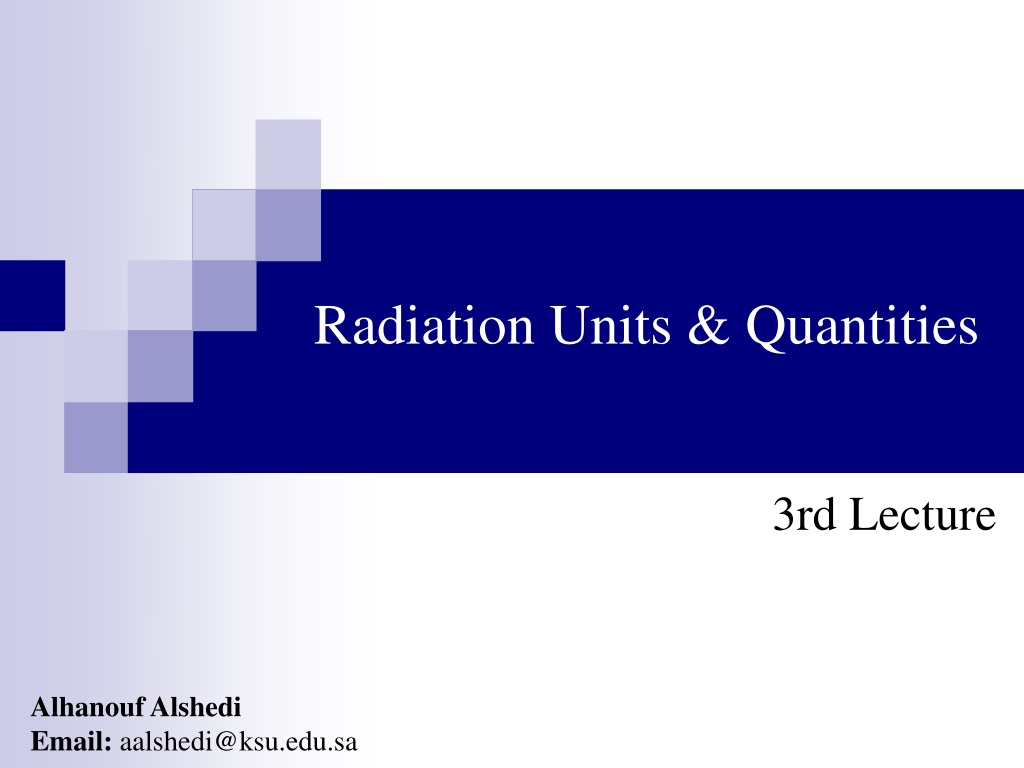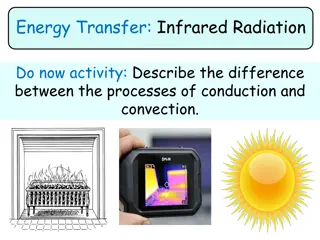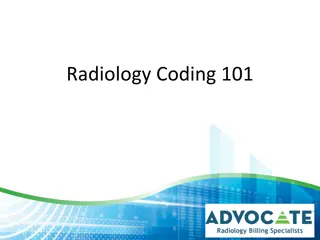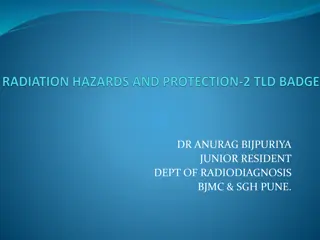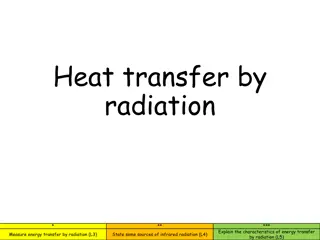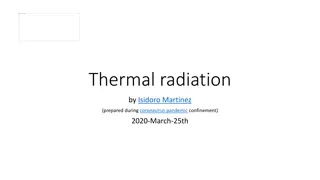Understanding Radiation Units and Dosimetric Quantities in Radiology
The field of diagnostic radiology relies on various dosimetric quantities and units to measure radiation exposure accurately. From the use of skin erythema dose to principles of ionization chambers, this lecture delves into the importance of understanding and calculating these quantities for effective radiation safety measures.
Download Presentation

Please find below an Image/Link to download the presentation.
The content on the website is provided AS IS for your information and personal use only. It may not be sold, licensed, or shared on other websites without obtaining consent from the author. Download presentation by click this link. If you encounter any issues during the download, it is possible that the publisher has removed the file from their server.
E N D
Presentation Transcript
Radiation Units & Quantities 3rd Lecture Alhanouf Alshedi Email: aalshedi@ksu.edu.sa
Subject matter: the basic dosimetric quantities Several quantities and units are needed in the field of diagnostic radiology and related dosimetry Some can be measured directly while others can only be calculated
Introduction Alarmed by increasing number of radiation injuries reported, therefore the scientists try to minimize the radiation exposure & use unit called it skin erethyma dose. This unit was defined as dose of radiation that causes diffused redness over an area of skin after irradiation. In 1937 ICRP has defined radiation unit which was Roentgen, although not accurately defined & has several limitation. In 1980 ICRP adapted SI units (international system of units) for use with ionizing radiation.
Effectiveness of Ionizing Radiation Heat and light are different forms of energy their effect appear as increasing in temperature which can be prevented by shielding or increasing the distance. However the radiation differ in that the increasing in temperature is very small even with lethal dose of Gamma nuclear radiation the temperature will increase by 1/1000 of 1 C which the skin is unable to sense so radiation. Radiation may cause a damage to the living tissue through a process of ionization ,which is a removal of an orbital electron from an atom to produce ion-pair as result of absorption of radiation energy.
Principles of Free Ionization Chamber Commonly the free electron will recombine with its atom but it can be prevented from recombination and that can be done by applying potential difference between two electrodes. so the ion-pair will be attracted to either side which forms the basis of measurement of the amount of radiation . To obtain a precise measurement of radiation exposure in medical radiography, the total amount of ionization an x- ray beam produces in a known mass of air must be obtained .
Cont. This measuring the amount of ionization an x-ray beam produces within its air collection volume. The instrument consists of a box containing a known quantity of air, tow appositely charged metal plates, device determines radiation exposure by and an electrometer. An instrument that measure the total amount of charge collected on positively charged metal plate. The chamber measures the total amount of electrical charge of all the electrons produced during the ionization of a specific volume of air at standard atmospheric pressure and temperature .
1- Exposure: The exposure is the absolute value of the total charge of the ions of one sign produced in air when all the electrons liberated by photons per unit mass of air are completely stopped in air. X = dQ/dm
The SI unit of exposure is Coulomb per kilogram [C kg-1] The former special unit of exposure was Roentgen [R]. 1 R = 2.58 x 10-4 C kg-1 C kg-1= 3876 R.
1- Absorbed Dose, D: It is the quantity of radiation energy deposited per unit mass of an absorber material. Absorbed dose, D (Gy) = dE (J) / dm (Kg) The SI unit is the gray (Gy), which is defined as the absorbed dose of one joule per kilogram. 1 Gy = 1 J/kg The former unit was (rad) 1 Gy = 100 rad
Cont. Anatomical structures in the body posses different absorption properties; some structures have the ability to absorb more radiation energy than others. The amount of energy absorbed by a structure depends on the atomic number of tissue composing the structure and the energy of the incident photon ;absorption increases as the atomic number increases and photon energy decreases. That's low-energy photons are in general more easily absorbed in material than are high-energy photons. The bone (atomic number =13.8) which is composed mainly of Calcium and Phosphor absorbs energy more than soft tissue (atomic number = 7.4) which is composed mainly of fat.
Factors Affecting Absorbed Dose Although the relative risk of potential injury increases with increasing radiation doses. The part of the body exposed. The time period over which the radiation dose is delivered. The age of the exposed individual. The type of radiation involved.
Absorbed dose, D and KERMA The KERMA (kinetic energy released in a mass) K = dEtrans/dm, where dEtransis the sum of the initial kinetic energies of all charged ionizing particles liberated by uncharged ionizing particles in a material of mass dm The SI unit of kerma is the joule per kilogram (J/kg), termed Gray (Gy). In diagnostic radiology, Kerma and D are equal.
2- Equivalent Dose, H Dose equivalent is the quantity commonly used to express the biological impact of radiation on persons receiving occupational or environmental exposures. Dose equivalent, H is proportional to the absorbed dose (D) and the type of radiation: Dose Equivalent, H = D x Q Where Q is the quality factor for the particular type of radiation involved.
Quality Factor Quality values provide a means for evaluating the relative hazards of different types of radiation. Q values assigned to different types of radiation. For x - rays, -rays, and particles, Q = 1, and for particles, Q=20. To avoid confusion with the absorbed dose, the SI unit of equivalent dose is called the sievert (Sv). The old unit was the rem 1 Sv = 100 rem 1 rem = 1 rad (1/100 )
Effective dose, E Radiation exposure of the different organs and tissues in the body results in different probabilities of harm and different severity The combination of probability and severity of harm is called detriment . Effective dose, E= T wTx HT E: effective dose. wT: weighting factor for organ or tissue T. HT: equivalent dose in organ or tissue T.
Tissue weighting factors, wT To reflect the combined detriment from stochastic effects due to the equivalent doses in all the organs and tissues of the body, the equivalent dose in each organ and tissue is multiplied by a tissue weighting factor, WT, and the results are summed over the whole body to give the effective dose E
Tissue weighting factors, wT WT Organ/Tissue WT Organ/Tissue Bone marrow Bladder Bone surface 0.12 0.04 0.01 Lung Liver 0.12 0.04 0.04 Oesophagus Salivary Glands Skin Stomach Thyroid Remainder Brain 0.01 0.01 Breast Colon Gonads Liver 0.12 0.12 0.08 0.05 0.01 0.12 0.04 0.12
Quality Factor for Different types of Ionizing Radiation Types of Radiation Quality Factor 1 X-ray photons 1 Beta particles 1 Gamma particles 5 Thermal neutrons 20 Fast neutrons 1 High-energy external photons 20 Low-energy internal photons 20 Alpha particles 20 Multiple charged particle
Quantity S.I Units Traditional Units Exposure Coulomb/Kg Roentgen (R) Absorbed dose Gray (Gy) Rad Equivalent dose Sievert (SV) Rem Effective dose Sievert (SV) Rem
Summary Dosimetric quantities are useful to know the potential hazard from radiation and to determine radiation protection measures to be taken. The old, non-S.I. quantities and units are mentioned, since these are still used in some countries, notably the United States ofAmerica.
Any Question? Thank You
